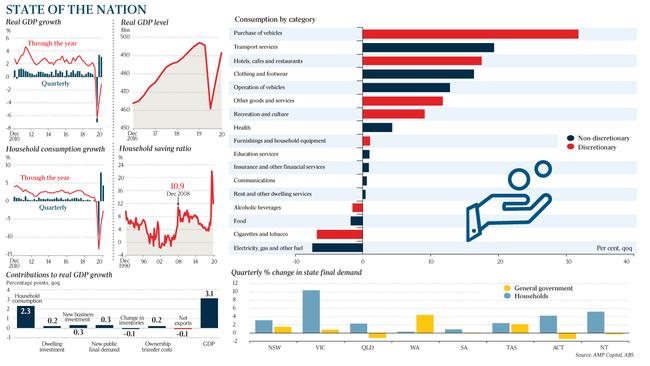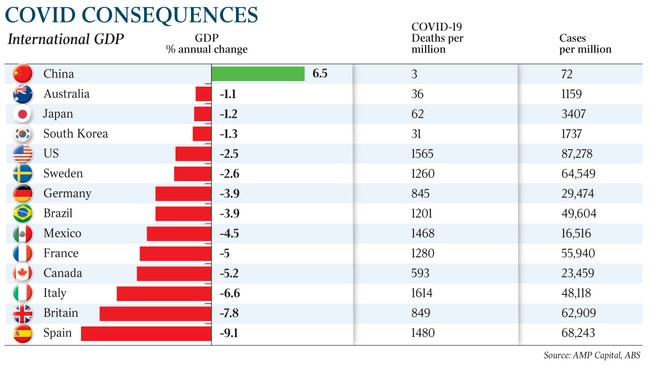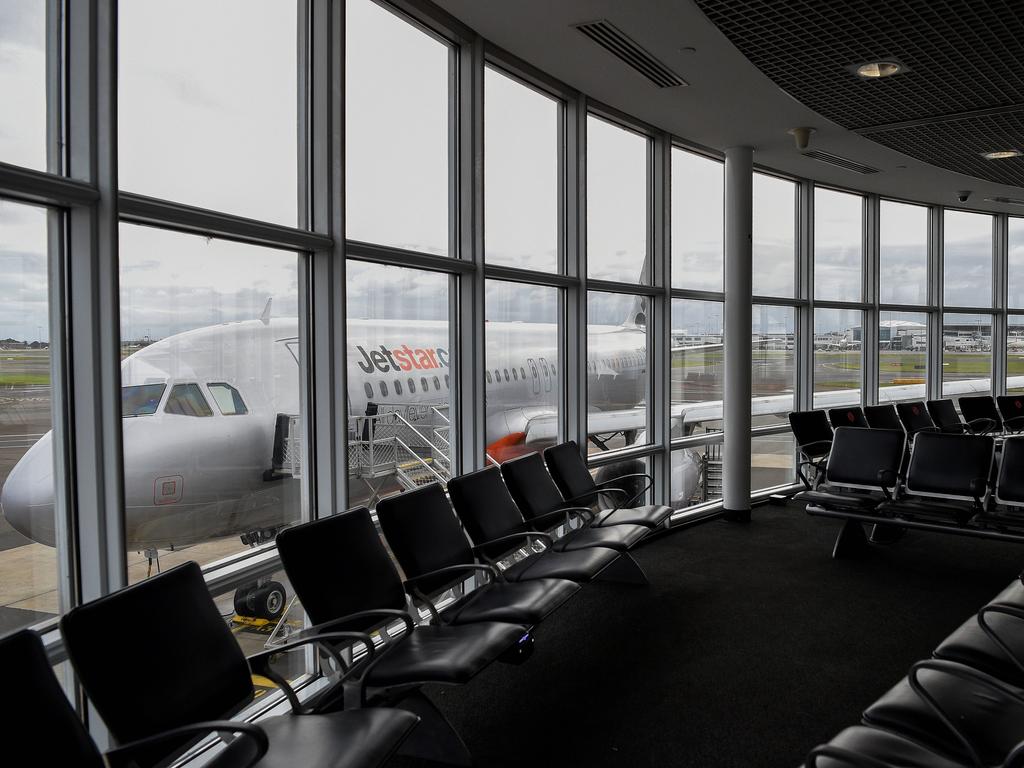Economy grows by 3.1 per cent in fourth quarter, smashing expectations
Australia’s rapid recovery from the downturn is confirmed by figures showing the economy expanded by 3.1pc in the December quarter.

The Australian economy has recorded its strongest six months of growth in recorded history, coming out of the COVID-19 downturn, after national accounts figures showed GDP in the December quarter smashed expectations to lift by 3.1 per cent.
On Wednesday, Josh Frydenberg said “the Australian economy begins 2021 in a very strong position”.
“There are still sectors and regions doing it tough, but our economic support will continue and today’s national accounts confirm that a strong, broad-based recovery is under way,” the Treasurer said.
It was the first time in the more than 60-year history of the national accounts that GDP had grown by more than 3 per cent in two consecutive quarters, the Australian Bureau of Statistics said.
The lift in growth happened despite an effective halving in direct government spending, as JobKeeper transitioned to a lower rate and cash handouts to households and businesses were not repeated in the final quarter.
“As our emergency support is tapering off, the private sector is stepping up,” Mr Frydenberg said.

The lifting of restrictions on Victorian households and businesses drove a stronger than anticipated lift in activity, the ABS said, with the state growing by 6.8 per cent over the quarter.
In contrast, state final demand in NSW lifted by 2.9 per cent, and by 2 per cent in Queensland.
Australia’s economy was 1.1 per cent smaller than it was a year ago, ABS data showed. Annual output through 2020, however, was 2.4 per cent, or $48bn, less than in 2019, revealing the hit to economic activity as a result of the health crisis.
KPMG chief economist Brendan Rynne said he now expected the economy to regain its pre-pandemic size by the middle of this year, while others predicted that could be achieved by March.
“That is an extraordinary comeback from the depths of mid-2020,” Dr Rynne said.
The Victorian economy, in contrast, remained 3.4 per cent smaller than a year earlier, and NSW’s 0.7 per cent smaller.
All other states have surpassed pre-COVID levels of economic output.
Queensland state final demand was 2 per cent higher than in the December quarter of 2019, and Western Australia’s 1.2 per cent larger, the ABS figures showed.
Consumption was once again the backbone of what economists variously called the “extraordinary” and “remarkable” growth figures, contributing 2.3 percentage points to the 3.1 per cent expansion.

Household spending lifted by 4.3 per cent, despite a 3.1 per cent fall in disposable income as Australians showed they were prepared to dip into more than the $100bn cash buffer accumulated through the crisis.
The household savings ratio dropped sharply from near-record highs of 18.7 per cent to 12 per cent, ABS figures showed.
There was an 18 per cent rise in spending on hotels, cafes and restaurants, in the quarter, while vehicle purchases jumped by nearly a third in the quarter.
NAB chief economist Alan Oster said “the strength of private sector activity is particularly encouraging as government support began tapering in the quarter”.
With consumer confidence riding high and a booming property market, economists are hopeful the economy will grow at an above-trend pace in this year and the next. That, in turn, will help create jobs and push the unemployment rate back towards its pre-COVID levels of 5.1 per cent, from the most recent reading of 6.4 per cent now.
A banner year for Australian farmers amid drought-breaking rains was also evident in the accounts. Gross value added — a measure of the contribution to output by industry — in the agriculture sector was up 22.5 per cent on a year earlier, the largest increase since 2008, after rising 27 per cent in the December quarter.
Grain output was 84.4 per cent higher than a year before, and there was a 64 per cent annual jump in cereal grain exports.
Particularly hard-hit segments of the economy such as accommodation and food services and transport — including aviation — enjoyed a solid lift in quarterly production of 7.9 per cent and 6.1 per cent, respectively, but were still 13.2 per cent and 16.8 per cent down on pre-pandemic levels.
Mr Frydenberg on Wednesday said the Morrison government continued to work through its options to provide extra support to COVID-affected sectors and regions, such as aviation, tourism and CBDs, signalling these measures would be revealed before the end of the month.
Opposition Treasury spokesman Jim Chalmers said the rapid economic recovery revealed in the national accounts was “remarkable” but given the impetus of removing restrictions in Victoria, ultimately “unsurprising”.
“This Treasurer doesn’t understand that what looks like a recovery on paper still feels like a recession for millions of Australians doing it tough,” he said.
Deloitte Access Economics partner Chris Richardson said while real GDP was down on a year ago, a better measure of living standards, real national income, was 2.1 per cent higher. This was thanks to a plunge in borrowing costs as the Reserve Bank slashed rates to 0.1 per cent, and a boom in terms of trade, led largely by a surge in iron ore prices above $US150 a tonne.








To join the conversation, please log in. Don't have an account? Register
Join the conversation, you are commenting as Logout